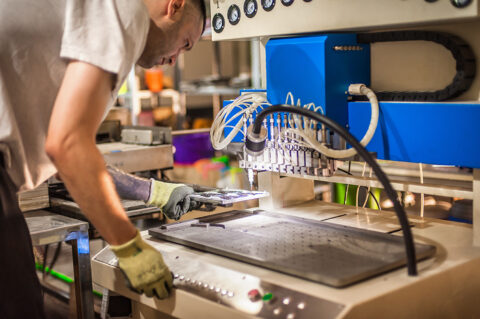🚀 Manufacturing Momentum Is Building—Fast
If you want a snapshot of where U.S. manufacturing is headed, this week offers a clear view: smarter factories, secure supply chains, and capital flowing at historic levels. From Detroit’s defense-tech summit to AI pilot programs in automotive and federal chip labs in Albany, the reshoring trend is no longer theoretical—it’s accelerating.
But growth isn’t without friction. New tariffs are looming. Trade signals remain mixed. And while billion-dollar investments capture headlines, small manufacturers navigating policy volatility still face operational uncertainty.
Still, one thing’s clear: American manufacturing is gaining momentum—mission-driven, strategically focused, and increasingly AI-enabled.
🧠 Story 1: AI Moves from Theory to Factory Floor
The Story:
General Motors expanded its AI footprint at Factory Zero, using machine learning for predictive maintenance and EV customization. The National Science Foundation debuted a new AI model that interprets real-time factory data for operational optimization. Clarios is launching a robotics and AI training center focused on workforce upskilling. Meanwhile, MIT’s “Initiative for New Manufacturing” partners with Siemens and GE Vernova to boost AI-driven productivity, especially for small manufacturers.
Why It Matters:
This isn’t automation-for-automation’s-sake. It’s AI as a force multiplier—augmenting human expertise and strengthening on-the-ground decision-making.
The Bigger Picture:
AI is shifting from buzzword to backbone. And if implemented relationally—not transactionally—it could give small U.S. manufacturers a critical edge in a global competition increasingly defined by digital infrastructure.
🔋 Story 2: Rare-Earths and Chips—From Bottleneck to Breakthrough
The Story:
MP Materials, America’s largest rare-earth producer, announced a tripling of capacity via its Texas and Mountain Pass facilities—backed by a $500M commitment from Apple and new DoD ownership. Meanwhile, the National Semiconductor Technology Center opened a next-gen EUV lithography lab in Albany using ASML’s EXE:5200B system.
Why It Matters:
Critical inputs like rare earths and semiconductors aren’t just economic—they’re strategic. These investments reduce dependence on global chokepoints and bolster national security.
The Bigger Picture:
This is textbook industrial policy—leveraging public-private capital to reshore high-leverage capabilities. If small manufacturers are integrated into these supply chains, the U.S. gains both scale and resilience.
💸 Story 3: Capital Is Pouring In—But Trade Uncertainty Clouds the Outlook
The Story:
The Trump administration announced over $100B in new investments targeting AI and energy, including $25B each from Blackstone and Google. At the same time, defense-tech VC investment reached $1.4B YTD, a 7× increase over last year. But these tailwinds come with turbulence: 30–50% tariffs on key trade partners are set to hit August 1, and Nvidia’s limited AI chip exports to China reflect ongoing supply chain volatility.
Why It Matters:
Investment momentum shows deep confidence in the manufacturing revival—but uncertain policy environments make planning harder, especially for smaller firms with leaner buffers.
The Bigger Picture:
Without coordinated strategy and long-term policy clarity, the risk is that capital concentration outpaces capacity distribution. That’s a strategic problem we can’t afford to ignore.
📰 Quick Hits
-
Facility Expansion: AB Electronics relocates to a 60,000 sq ft site in Danbury, CT—aiming for 4× growth and up to 200 employees.
News Times -
Output Update: June U.S. factory production rose 0.1% (+0.8% YoY), extending modest gains but showing signs of Q2 cooling.
Reuters -
Tariff Tracker: New 30–50% tariffs on imports from EU, Mexico, Canada, Japan, and Brazil begin August 1. Sentiment among MI manufacturers remains surprisingly upbeat.
Yale Budget Lab -
China Watch: U.S. partially resumes Nvidia AI chip exports to China (H20 chips), reflecting tactical trade recalibration.
AP
🔭 Looking Ahead
This week confirmed that manufacturing transformation is not only happening—it’s accelerating. But as capital flows and technology adoption scale, the next challenge will be execution: ensuring small manufacturers aren’t left behind in an increasingly AI- and policy-driven landscape.
Next week, we’ll be watching developments in industrial energy infrastructure, new legislation supporting workforce apprenticeships, and emerging use cases for additive manufacturing in defense.




